How to Make an App for Your Business: Choosing the Right Niche and Features
Updated 16 Mar 2023
20 Min
3031 Views
How to create an app for my business? That’s an exciting question that most entrepreneurs ask themselves when searching for new opportunities. Mobile apps can increase your business' potential, engage customers, and boost sales. After all, they may become an independent source of income. According to Statista, the global mobile app revenue will reach $940 billion in 2023.
However, app development is a tricky process with its nuances and pitfalls. It requires in-depth niche research, tech-savviness, and wise budget planning. In this post, we’ll discuss different software development approaches, requirements for various niches, and main features for popular app categories.
Why You Should Make a Business App
These days, it's almost impossible to imagine a business that doesn't have a web platform or app. To get ahead of the competition and motivate your audience to seek your services, it's worth incorporating such a product into the workflow of your entity. Let's look at the main reasons why applications are necessary for standing out from the crowd on the market.
Refined business image
Having a quality company mobile app is an excellent way to demonstrate to customers that your business is up to date, making you a credible service provider in the eyes of clients among the crowd of competitors. Mobile-first development provides an opportunity to get a high user engagement as well as retainment level due to the user-friendliness, handiness, and convenience brought by high-quality applications.
Enhanced loyalty and personalization
Loyalty programs that reward customers who order your products/services on a regular basis can be integrated and automated within your app. Besides, the software is able to analyze customer requirements to ensure personalized offers, individual discounts, and many other pleasant and engaging benefits. Physical club and rewards cards, which a customer may forget or lose, can be replaced by a mobile app on the device, which once again delivers a high satisfaction rate for clients.
Perfect communication with the audience
This aspect depends primarily on the domain and the concept of the business. However, in a prevalent number of cases, the application can serve as a unified system of communication channels with consumers, which will provide a modern level of user service and high customer orientation.
Substantial sales raise
In a modern world of digitalization, any individual can't do without using a smartphone on a daily basis. The icon of your application on the audience's device home screen, accompanied by push notifications, establishes continuous connection and communication with customers, as well as allows applying various types of purchase incentives.
Relevance and interactions monitoring
The application is able to track all the interactions and processes performed by a particular customer. Thus, you will be able to track customer behavior patterns as well as determine their requirements to deliver high personalization and utter demands complying.
Figuring Out General Requirements to Make a Business App
The main thing to remember is that software development isn’t only about programming. It’s a multicomponent process that includes the labor of various specialists. Business analysts, Quality Assurance engineers, UI/UX designers, project managers, and programmers work together to plan and create the app for your business. After the initial contact, analysts make a rough estimate of your project and negotiate on the development process.
Let’s take a closer look at each stage of the development. Please, mind that the development process varies in different companies. We’re describing the process based on our experience.
Planning phase
During the planning phase, you cooperate with business analysts to figure out the requirements for your project.
When all questions are settled, you proceed to the actual planning stage. Here, you have to provide the software development company with an inner vision of the product and detailed instructions on how everything should work and look like. Business analysts write specifications for engineers based on the information you gave, while designers create wireframes that display UI elements on each screen of the app. After your approval, engineers are starting to build the app for your business.
Learn more about the discovery phase and its price with this article
Market research
Before you start developing your own mobile product, you need to analyze whether it will be on-demand on the market. The demands of your target audience, as well as the existing industry leaders in your business, should also be taken into account and considered. An in-depth and detailed re-survey will help identify the strengths and weaknesses of competitors, market trends, as well as customer requests, the satisfaction of which will have an impact on increasing the profitability of your business and application.
An effective way to conduct such research is the SWOT analysis, which refers to the method of planning and a tool for evaluating external and internal factors which affect the way a company or a specific application develops on the market. This acronym includes the following items:
- S (Strengths) - potent and solid aspects, characteristics of the business that distinguish it from its competitors
- W (Weaknesses) - infirm sides, which make the company vulnerable, reduce its competitiveness in comparison with other players in the sector
- O (Opportunities) - possibilities, elements of the environment that the company can use for development;
- T (Threats) - dangers, elements of the environment that can cause damage to the business
These components are divided into factors of the external and internal environment. In the first case, it is usually about the characteristics of the business, which it can deal with or impact. In the second case - the factors can only be beaten or at least neutralized.
Design
UI/UX designers put in the hours to deliver an attractive and user-friendly app design. Wireframes, mockups, prototypes, fonts, and the design of every element is their field of concern. The time designers spend on the project depends on its overall complexity. The more features your app has, the more time designers need to build layouts and draw every small component.
Every app niche has some design peculiarities. For example, interactive elements like buttons should visually stand out among non-interactive elements. On top of that, the text should be easily readable. That’s why white text shouldn’t be placed on the light background. To find a company that offers UI/UX design services, you can use Dribbble. This service lets you browse through design projects of different companies and independent designers.
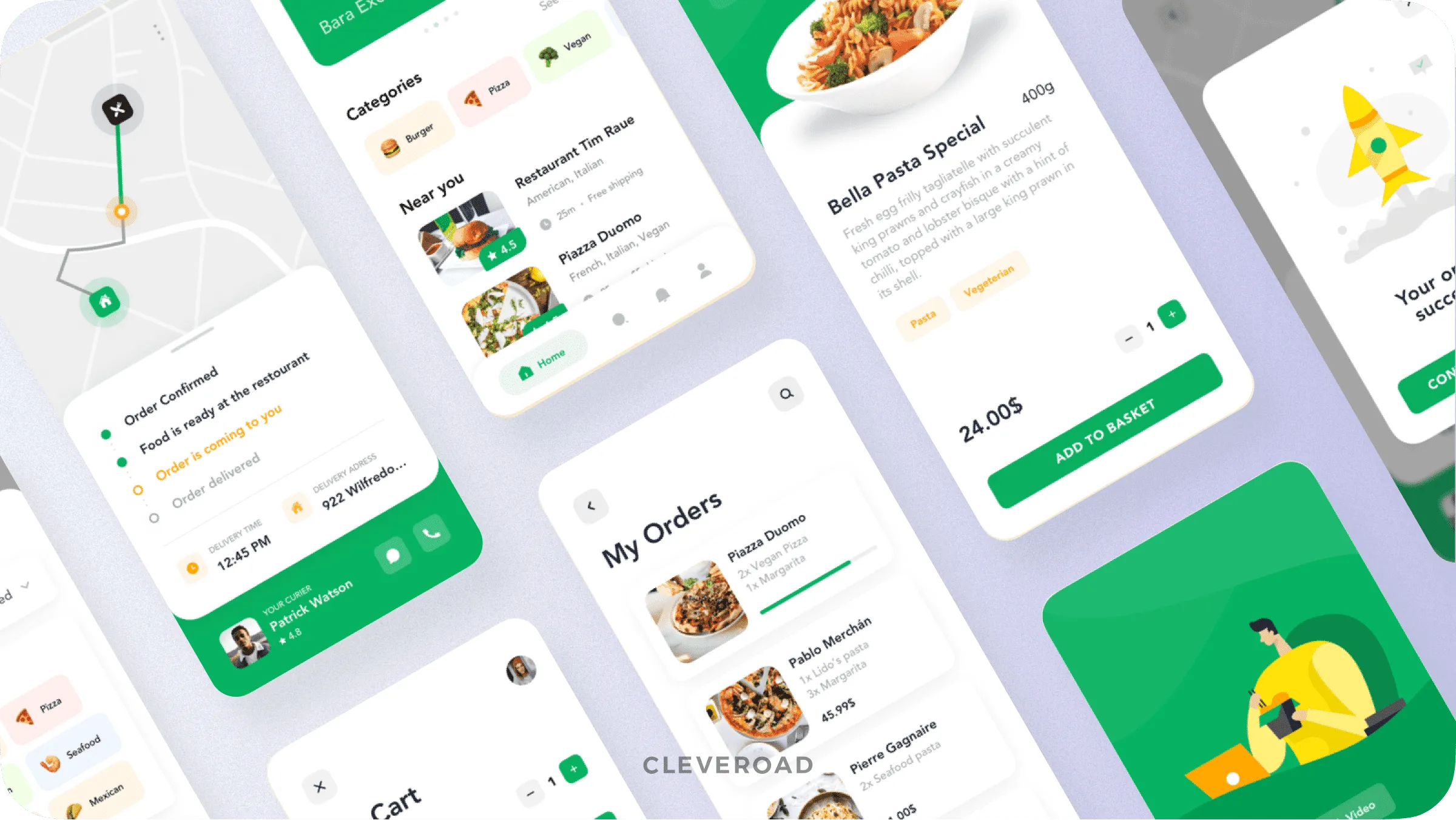
UI/UX design of a food delivery app by Cleveroad
Software development
Software engineers create business logic for your app. Based on your requests, they implement the first version of the mobile app. For complex, multifunctional, and feature-rich projects, as a rule, primarily the MVP version is created - a mobile application with minimal functionality, however, sufficient to start its usage and receive initial feedback from the first users on the application.
Aside from this, developers integrate the list of essential APIs - services to transfer data between the server and the solutions and expand the app's capabilities. To create an app for your business, they have to be proficient with the tech stack required for a certain niche and platform. Thus, for an Android food delivery app, programmers should know how to use Kotlin or Java and implement geolocation.
Quality Assurance
QA engineers cooperate with software developers throughout the project. Their task is to test the project, document bugs, and return the software for fixing. It is vital to start testing the application on real devices as early as possible and to do it maximally often. Even devices with the same hardware specifications may react differently to usage cases. Also, keep in mind that if a specific element operated smoothly during the early testing phase, it does not guarantee that there won't be any bugs and flaws in the final one.
To determine and fix performance faults, the QA department applies a range of manual and automated tests aimed at the operation quality increase. Testing is a critical phase in creating an app for your business. Failures and vulnerabilities lead to inconveniences and severe problems with data safety. That’s why you have to get rid of them as early as possible.
Maintenance and support
A prolonged app's life cycle, competitiveness, and demand are determined by the support services delivered for the business app. The main tasks of technical support for a mobile application are as follows:
- Receiving feedback from users, overcoming the challenges they complain about
- Checking and enhancing the performance of the application
- Upgrading the functionality according to the ever-changing market and client requirements
- Realizing updates for new devices and operating system versions
It's vital to understand that marketing is an ongoing process and an integral part of support. The more actively you talk about the app, the more effective it will work for you.
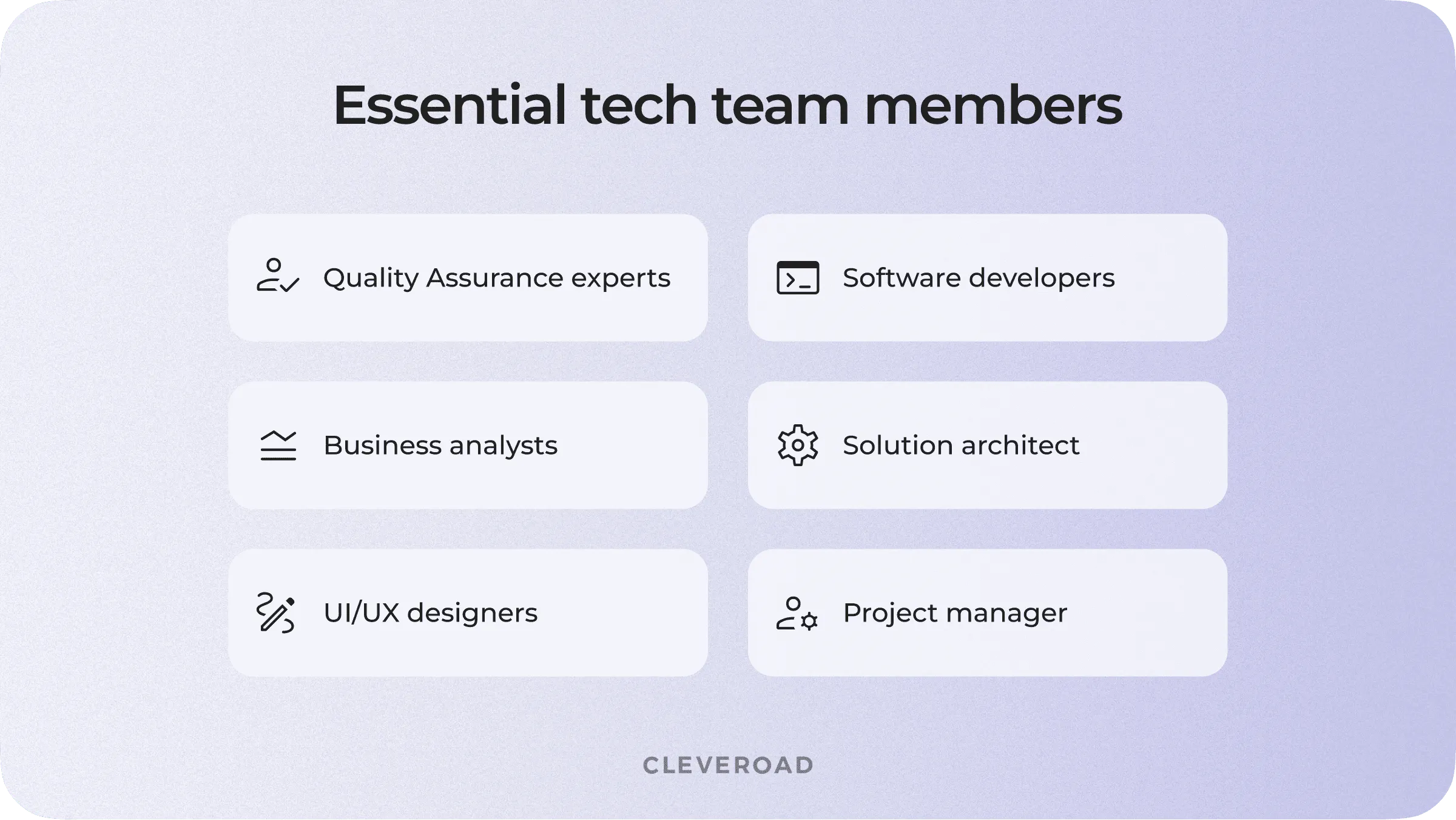
Main members of the software development process
These were the main stages of software development. However, before contacting the team, you have to figure out the requirements for your software. There are many things to consider, like the number of platforms, development approach, and so on.
Choosing the Approach to Create an App for Your Business
Not every company possesses enough financial resources to afford the creation of native apps simultaneously on both Android and iOS, tailored to each of those platforms. This is due to the fact that the final products are two standalone applications, the architecture of which requires the use of specific programming languages as well as other digital instruments.
Besides, such software solutions require separate maintenance and support services due to the OS peculiarities. However, at the moment, there are several ways to overcome this challenge and invest the budget wisely, in accordance with your business requirements. Therefore, let's take a look at the most common development approaches and select the appropriate one for your case:
Native Development
How to build an app for your business with a native approach? In simple words, native project is the same software built for both platforms individually. Native projects are written with programming languages designed for specific platforms. Java and Kotlin are native Android languages. As for iOS developers, they use Objective-C and Swift.
But what’s the point of building two separate projects for both platforms? In fact, there are several reasons. The major of them is performance. With native development, engineers can use devices at full capacity. Power-intensive tasks like photo/video processing, GPS navigation, and others require a lot of CPU, GPU, and RAM resources. Native development lets engineers distribute resources correctly and achieve a smooth performance even on outdated devices.
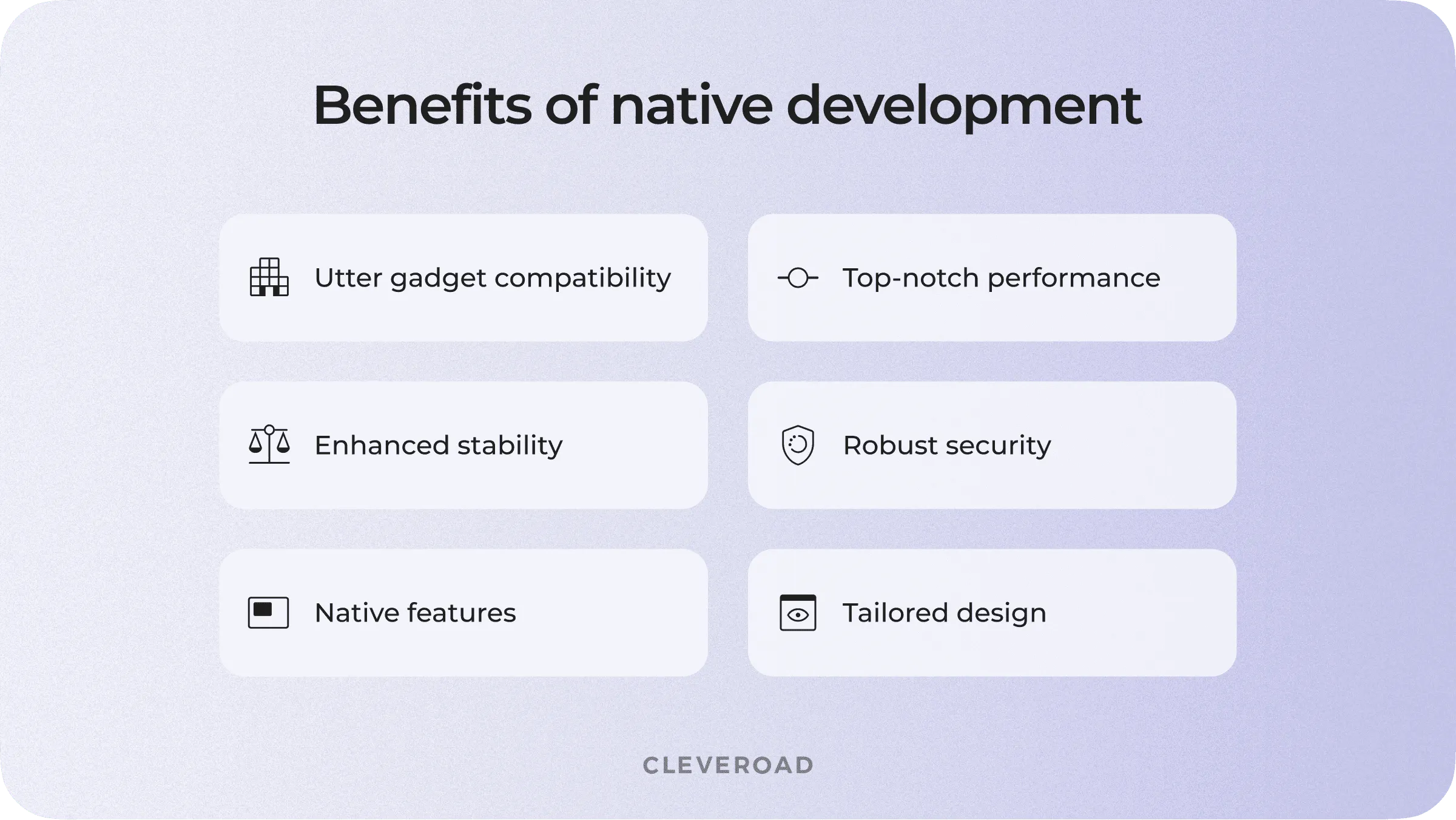
Three main benefits of native app development
However, this approach is much more time-consuming. To create an app for your business with a native approach, you have to find at least two developers who’ll work with iOS and Android codebases and pay both of them.
Cross-Platform and Hybrid Apps
These two approaches shorten the time-to-market compared to native development. Want to know how to make an app for your business in the shortest terms? Let’s see what cross-platform apps can offer.
Cross-platform apps stand side by side with native development. These apps require native code to manipulate the app’s UI. The main part can be written with various frameworks like Xamarin, React Native, PhoneGap, and more. When both parts are assembled, they need a bridge to communicate. And here’s the point where cross-platform loses performance. Because of the code transition from one language to another, the app loses FPS, and the overall image may be chopped.
Still, Flutter is the only cross-platform framework that allows you to create an app for your business with a smooth 60 FPS on all devices. It uses Dart programming language and doesn’t require a communication bridge in most cases. Besides, Flutter doesn’t have issues with the design. Its main concept is “everything is a widget”. In simple words, developers can customize each element on the layout per requirements.
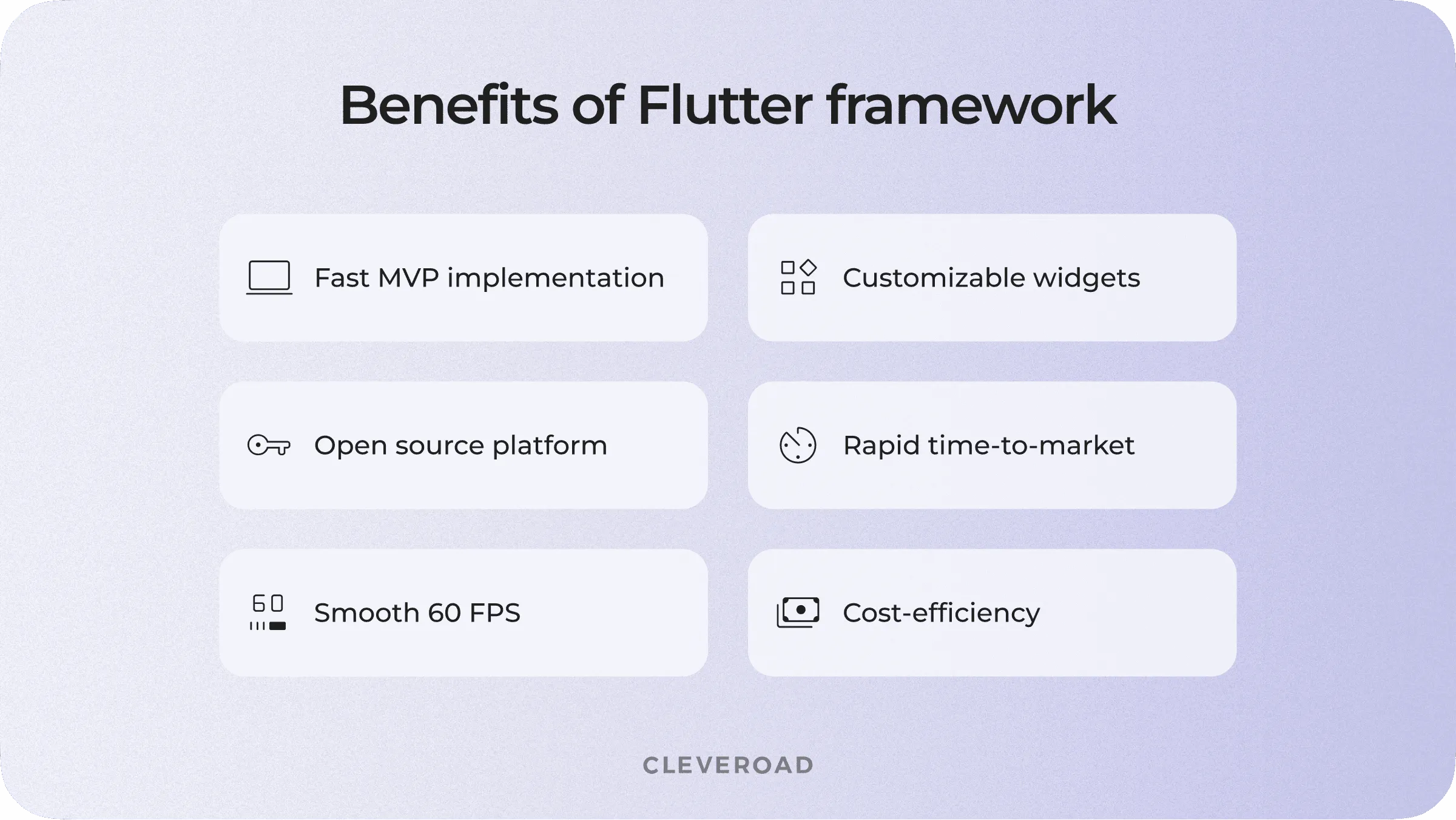
Three main benefits of Flutter framework
Want to know how much it costs to make an app for your business with Flutter? Here's our guide on Flutter app development cost estimates and project examples.
In their turn, hybrid apps display the app content in a web-view and have to be installed like native apps. They can operate on both platforms reducing the development time in half.
However, hybrid apps have the poorest design among all the listed above. On top of that, these apps may have performance issues and a lack of custom features.
Which Approach to Create Business Apps Is Better?
It’s impossible to say what development approach to use without knowing project requirements. If you’re on a budget and need a fast product launch, a cross-platform or hybrid app may be your choice. However, if you’re planning to develop complicated custom features and sophisticated design, you should go for native development.
So, how to create an app for your business that fulfills your expectations? For a better understanding, we’ve created a comparative table.
| Attributes / Approach | Native | Cross-platform | Hybrid |
Development cost | The highest cost to develop an app for both platforms | Cross-platform and hybrid apps are almost twice as cheap as native development | |
Performance | With well-built logic, native projects have the best performance | Conversion from one API to another reduces performance | Web-view has terrible performance with complex features |
Device’s features | Native apps have access to each feature of the device | Because of the indirect communication with the device’s hardware, these apps can’t get access to some native features | |
User interface | UI and navigation are limited only by the designer’s ideas | Flutter allows customizing the app in many ways | Web-view has poor navigation and suits for displaying content |
Code reusability | Native code can be used only for a single platform | Apart from native, all the code can be used for both platforms | |
Updates | Update price is calculated for every platform separately | Due to a single codebase, the update price includes upgrades for both platforms | |
Diving Into Industry-Specific App Requirements
Well-built business logic and attractive design aren’t enough to make an app for your business successful. Feature list, market analysis, user research, and risk assessment are integral parts of the project. Moreover, these steps fall entirely upon the product owner’s shoulders. Even though business analysts can help to clear out the tech stack and MVP features, the global requirements should be prepared on your own.
We’ve made a list of popular niches with possible app features and approximate tech stack.
E-Commerce
Online retail is a highly customizable niche in terms of design and features. To create an MVP app for your business and conduct user testing, you have to develop the following features:
- Registration/Authorization
- Homepage
- Catalog
- Product page
- Shopping cart
- Payment gateway
- Technical support
And here's the tech stack for an e-Commerce software:
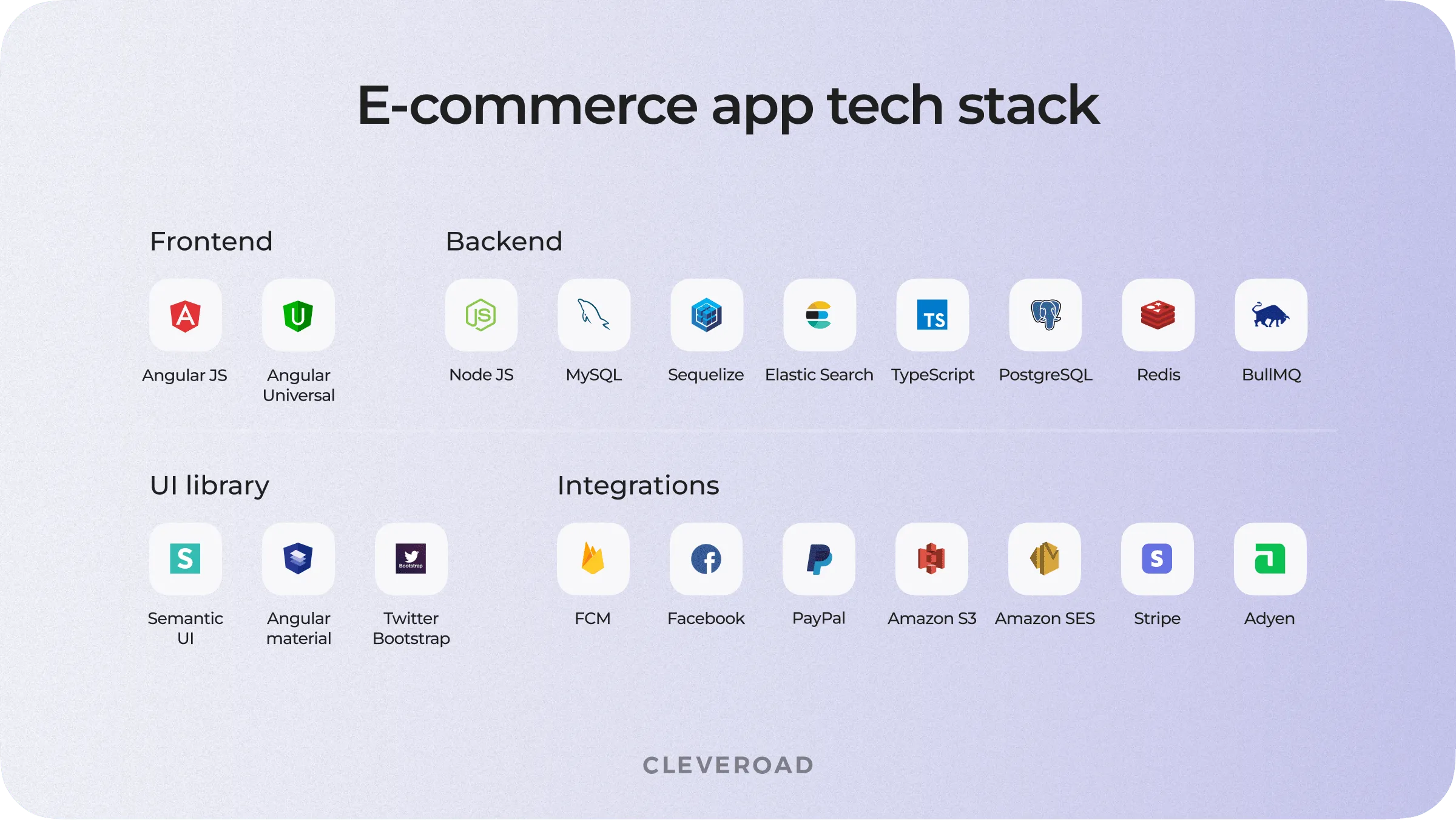
Main technologies for an e-Commerce app development
Healthcare
Telemedicine apps gain popularity due to the time-efficiency and convenience they bring to patients. Healthcare providers offer a range of health plans for clients. Thus, physicians can observe patients remotely, manage prescriptions, monitor their health condition, and supervise the treatment process.
Telemedicine apps are similar in structure, so here’s a feature list for creating a telehealth app for your business:
- Registration
- Keeping and viewing EHRs
- Search for a physician
- Video conferencing
- Text chat
- Managing appointments
- Payment system
- Review system
- Notifications
Don’t forget that telemedicine apps deal with electronic health records that are protected by HIPAA regulations. Violating these regulations may lead to large fines and even criminal liability. That’s why you have to treat HIPAA regulations seriously and eliminate all possible vulnerabilities.
Let’s run through a tech stack for telemedicine app development:
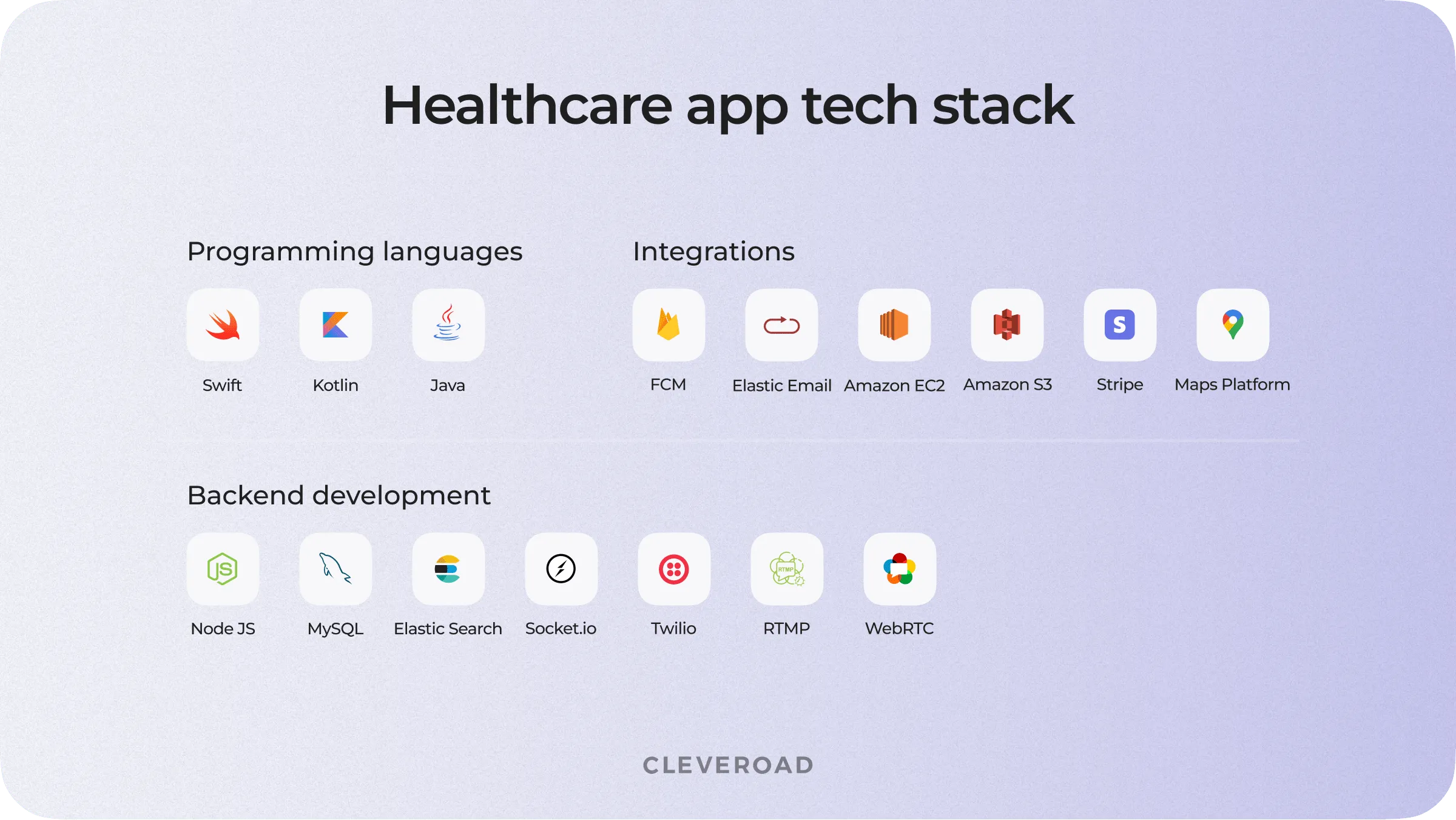
Technologies for a telehealth app development
Streaming
Streaming is a vast entertainment niche popular among generation Z and millennials. According to different statistical services, around 80% of US people between 18 and 34 have subscribed to a video streaming service. Live streaming is another form of entertainment that bridges celebrities and influencers with their audiences. Entrepreneurs earn profit on streaming platforms by integrating ads and adding paid subscriptions that bring specific benefits to users.
This guide explains how to develop a live streaming app, like Twitch, Periscope, and YouTube Live
So, how to build a business app for streaming? For an MVP version you’ll be good to go with this feature list:
- User registration
- Creating a personal user profile
- Online streaming
- Comments to broadcasts
- Search
- Server-side (ability to convert stream)
And now, let’s glance at the tech stack required to create an app for your business:
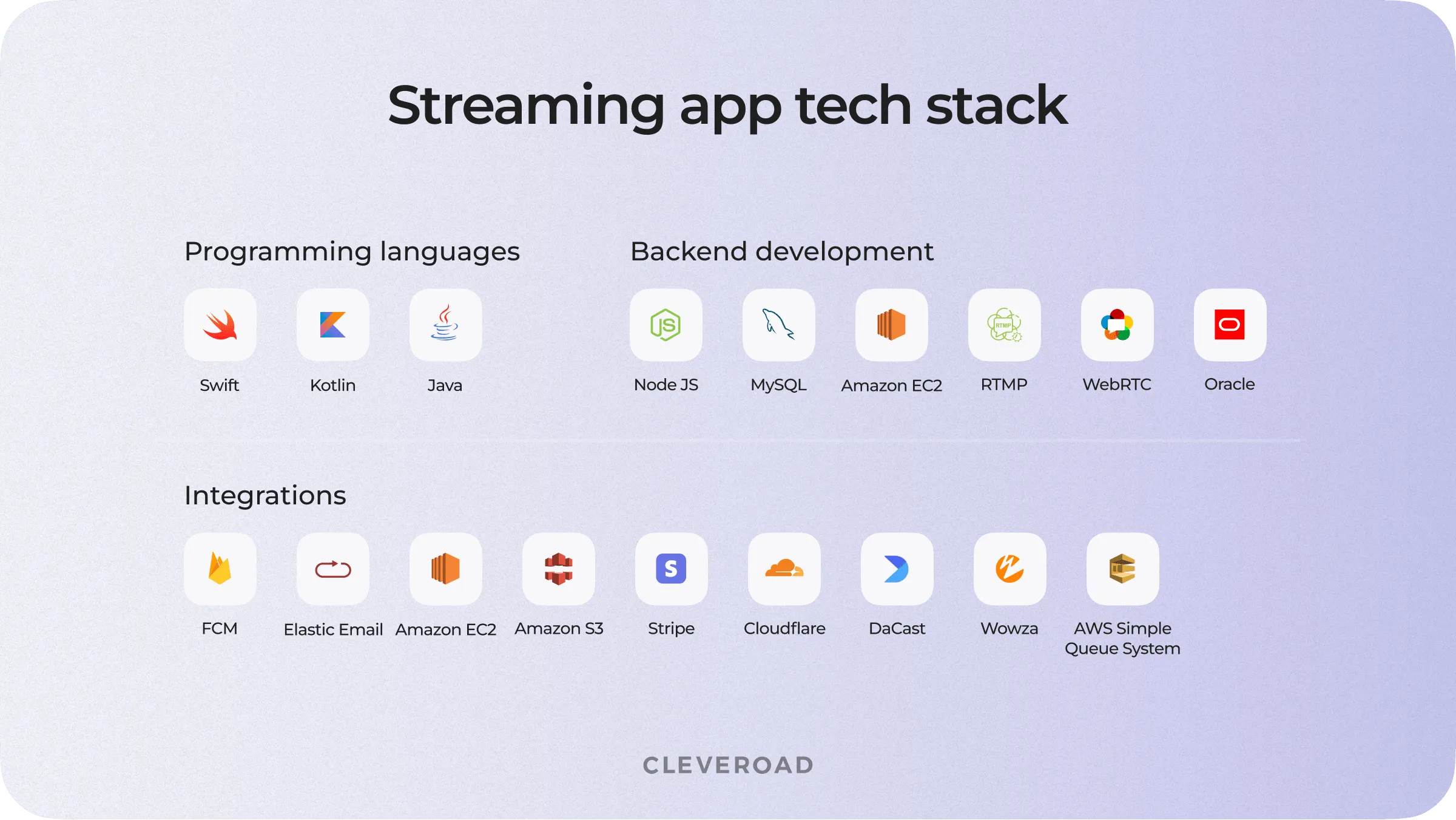
Tech stack for a streaming app development
E-Learning
E-learning giants like Coursera and Udemy have been proving the efficiency of remote education for years. They collaborate with top-tier universities and experienced private tutors to bring maximum opportunities to each student. Efforts have paid off, and Coursera became a billion-dollar-worth company with 64 million learners.
We’ve prepared a educational app development cost estimate and explained each possible business model.
What’s the secret of a successful e-Learning app? We’ve disclosed main features for creating an app for your business:
- Authentication and user profile
- Filtering system
- Dashboard
- Course page
- Payment systems
- Course adding page (for tutors)
- Notifications and reminders
- Admin panel
And here’s the tech stack required for the development:
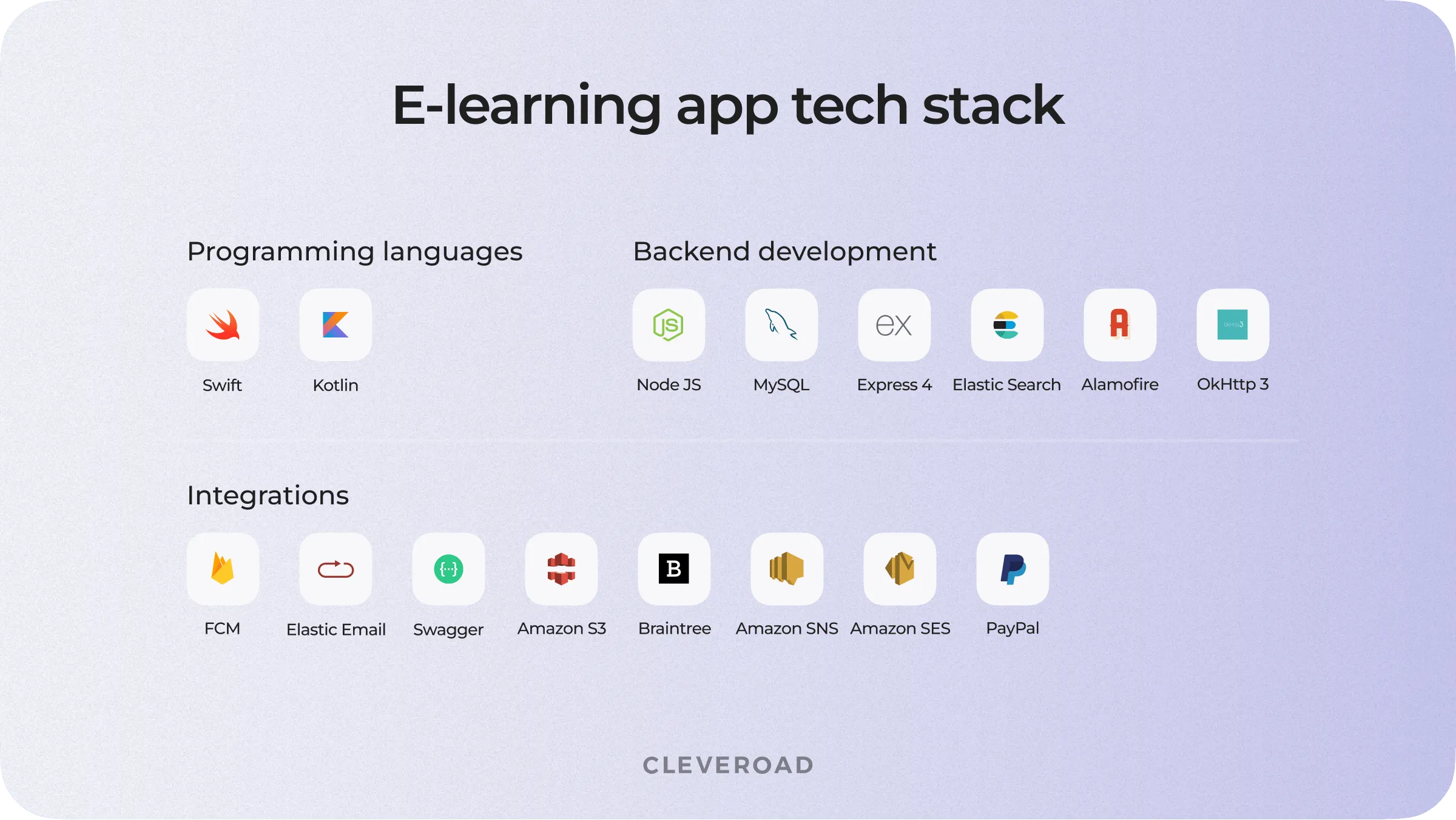
Common technologies for an e-learning app development
Logistics and delivery
The active development of global logistics is motivating more and more companies to develop applications for this industry. Let's delve into the features of supply chain applications, as well as logistics, like laundry mobile app development and other Uber-like apps with the example of a food delivery business application.
In case you’re a restaurant owner, you can start your own Uber business as a food delivery service can expand the customer network and boost sales. So, let’s discover the key features for this kind of app and technologies that can be used for creating an app for your business.
A comprehensive guide on a food delivery app development with features, tech stack, and marketing tips
Don’t forget about the menu, shopping cart, and checkout. Plus, users should be able to specify the details in their order like removing onion from a burger. Its integration takes time and money, but it relieves you from dealing with cash.
Feature list for a food delivery app:
- Registration/Authorization
- Menu
- Meal details
- Text chat
- Geolocation
- Shopping cart
- Checkout
Approximate tech stack for a food delivery app:
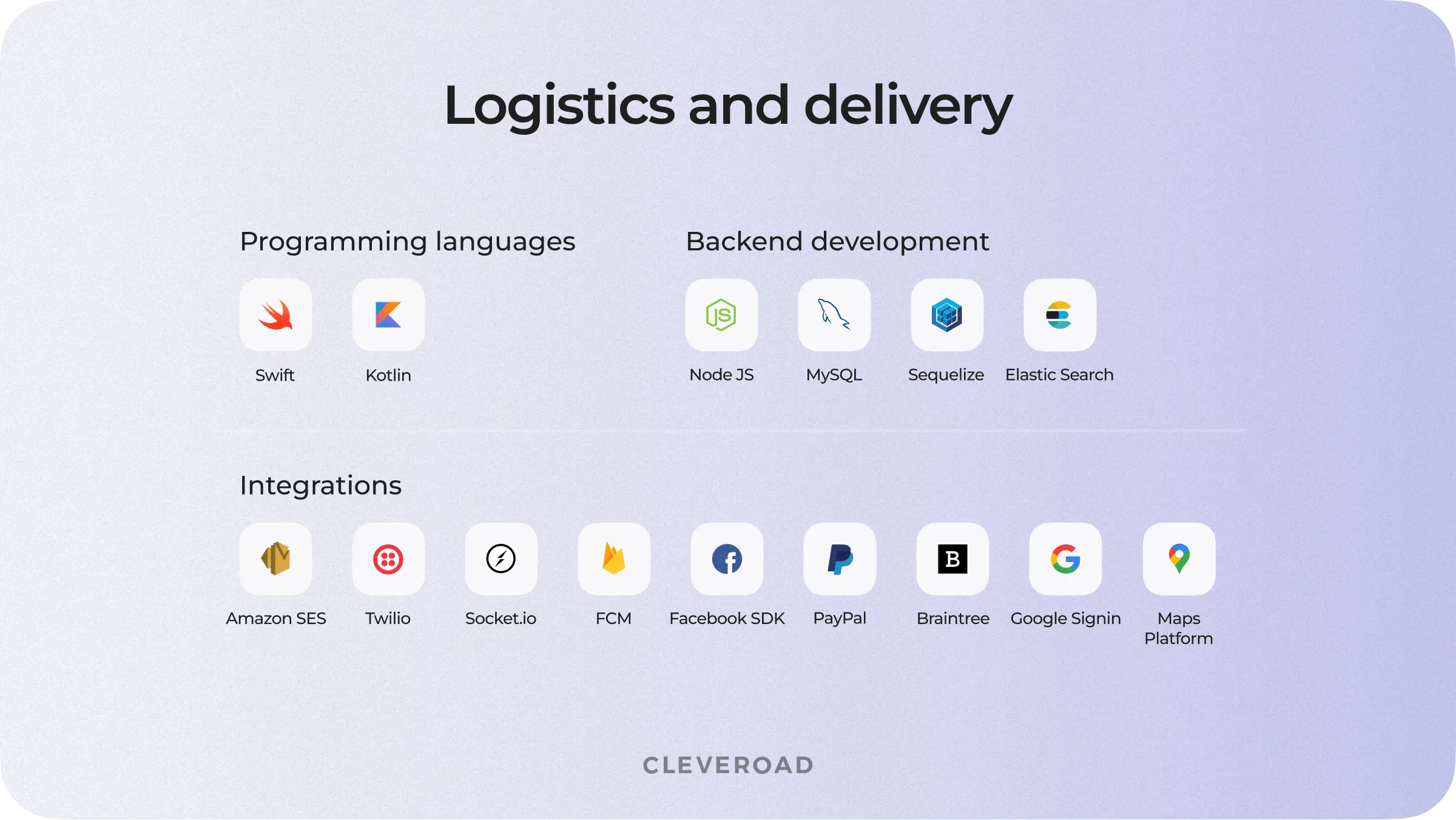
Main technologies for a food delivery app
Map integration is an essential feature in this case. With its help, clients will see the restaurant’s location and determine the coverage area of your delivery service. In case you’re building an app for your business on a budget, you can create a simple text field for transmitting the destination to couriers. They’ll get the text message with an address in the app. However, if you’re ready to spend the extra money, you can use geolocation. It’ll transmit the user's position to a courier and vice versa in real-time.
How to Build an App for Your Business?
We’ve figured out software development approaches, main project requirements, and highly demanded niches. But the main question remains. How to make an app for your business?
Basically, every entrepreneur has three options:
- Outsourcing software development
- In-house development
- Freelance developers
We don’t consider various app builders as an acceptable solution to create an app for your business. Such services deliver inflexible software with poor customization. It may be the cheapest and fastest option to build a primitive app with raw design. But when it comes to customizable features, this option completely loses its ground.
Now, we’ll learn about all the software development options.
Software Development Company
Outsourcing custom mobile development is a well-established option. When entrepreneurs need to create an app for their businesses in certain timeframes for a reasonable cost, they contact software development companies. Usually, these companies have much lower rates compared to in-house teams that may cost you a fortune with all side expenses like office rent, hardware and software purchase.
Looking for a tech partner?
We will assist you in picking a feature list and deliver a project estimate due to your demands
However, to find a reliable partner, you have to conduct research. The highest price doesn't guarantee the best quality. Also, don’t fall for the most attractive price. Services, like Clutch and GoodFirms, allow entrepreneurs to browse clients’ reviews about companies. We consider these websites the most valuable sources of information while looking for a tech partner. Clients’ feedback can’t be falsified because of the verification measures.
Now, what about the price to build an app for your business? Developers from different regions have different rates. Here are the prices in the most well-known outsourcing tech hubs.
| Region | Developers’ rates ($/hour) |
North America | $150-$200/hour |
Western Europe | $50-$149/hour |
Central/ Northern Europe | $25-$49/hour |
Oceania | $100-$150/hour |
Asia | $20-$40/hour |
South America | $25-$49/hour |
In-House Team
An in-house team is a group of developers that work a full-time job in your company’s office. Successful companies with large budgets always have in-house development teams at hand. The main benefit of this option is improved control over the workflow of your employees. You’re always aware of the project condition, stumbling blocks, and difficulties that appear while creating an app for your business. Also, a stable team is excellent for maintenance of existing projects. No one knows the codebase of the app better than its original developers.
However, the in-house team is an expensive idea for startups. According to Glassdoor, American mobile app developers earn $80,000/year. The team of three developers, one designer, and one QA engineer, will cost you around $400,000/year. Don’t forget about the office rent, purchase of the hardware and software, compensations, and many more. Additional expenses may increase the price almost twice.
Freelance Developers
Finally, we’ve reached the last option on our list. Without a doubt, freelance developers are the cheapest option for software development. Unfortunately, that’s the only freelancers’ advantage.
But what’s so bad about freelancers? When you hire a software development team to make an app for your business, you’re paying for a project manager who will coordinate the development process and keep you posted. With an in-house team, you stay in charge of the development team. But when it comes to freelance developers, it’s a cat in a bag. Communication issues are a common thing with freelancers. They may take the advance payment and contact you again in several weeks.
Also, freelancers usually don’t bother with quality assessment. So, after months of development, you can get a product full of bugs and vulnerabilities. What’s most disappointing is that you’ll have to find another person to fix them or pay the same developer even more.
Make a Business App with Cleveroad
Cleveroad is your reliable IT vendor from Estonia. We specialize in a range of tech service delivery, and mobile product architecture is one of our central focuses. Our Agile-oriented professionals implement solutions of diverse complexity for the most demanded sectors to streamline and enhance business productivity.
Let us demonstrate our expertise in practice by presenting some of our successfully accomplished projects:
Our team of certified app software engineers has developed a brand new version of RetailOps, a SaaS platform for retail. It helps warehouse owners to manage the inventory and automates a range of goods tracking tasks.
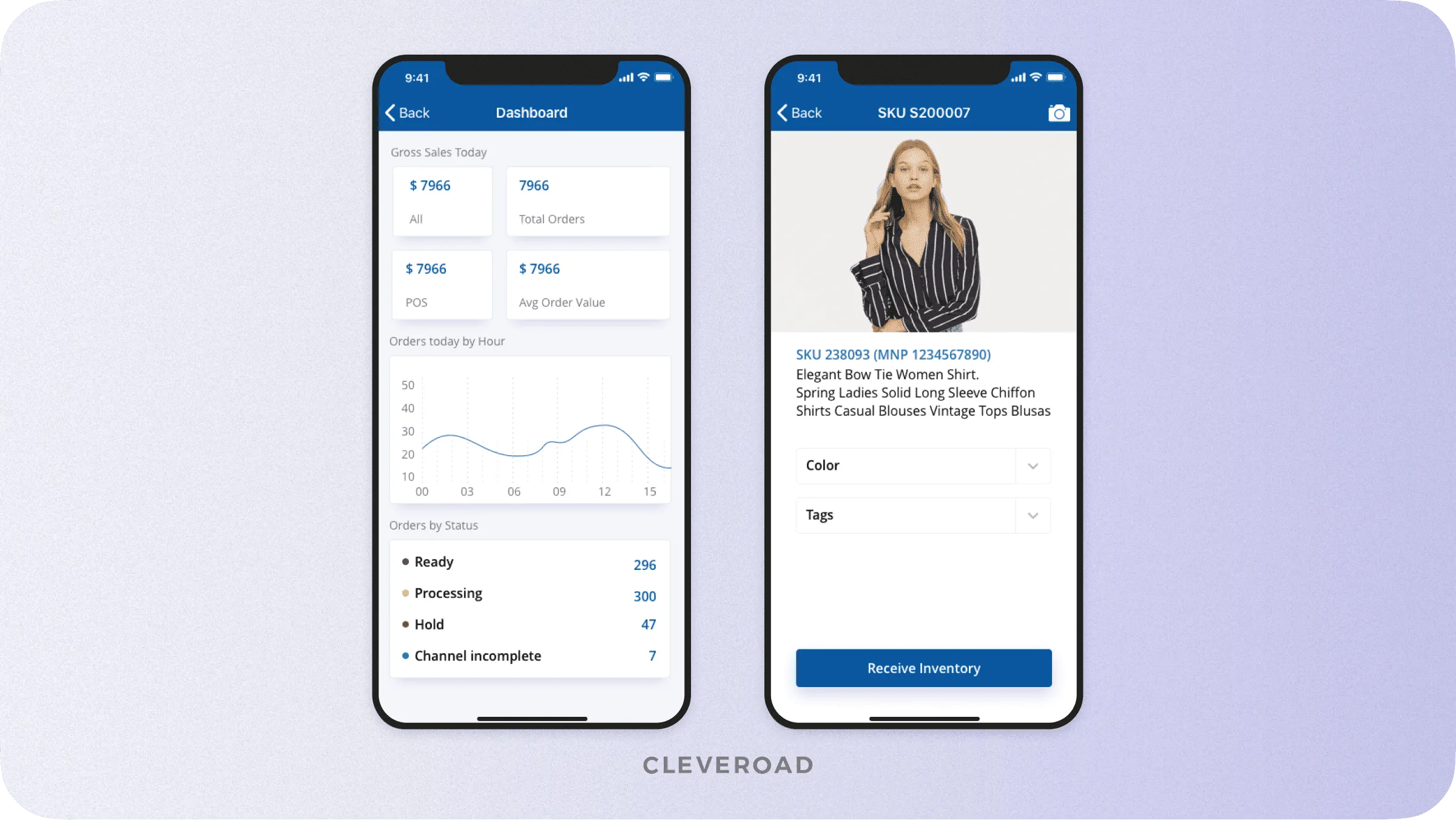
Cleveroad expertise: RetailOps
Blockbuster is another interesting project we were working on. A former movie-rental company sold its brand rights to the Danish movie streaming company. We’ve upgraded Blockbuster’s mobile apps for a variety of platforms including iOS, Android, Web, and Smart TVs. Now Blockbuster has collections of users’ favorite movies and series, downloading of content, and subtitles in multiple languages.
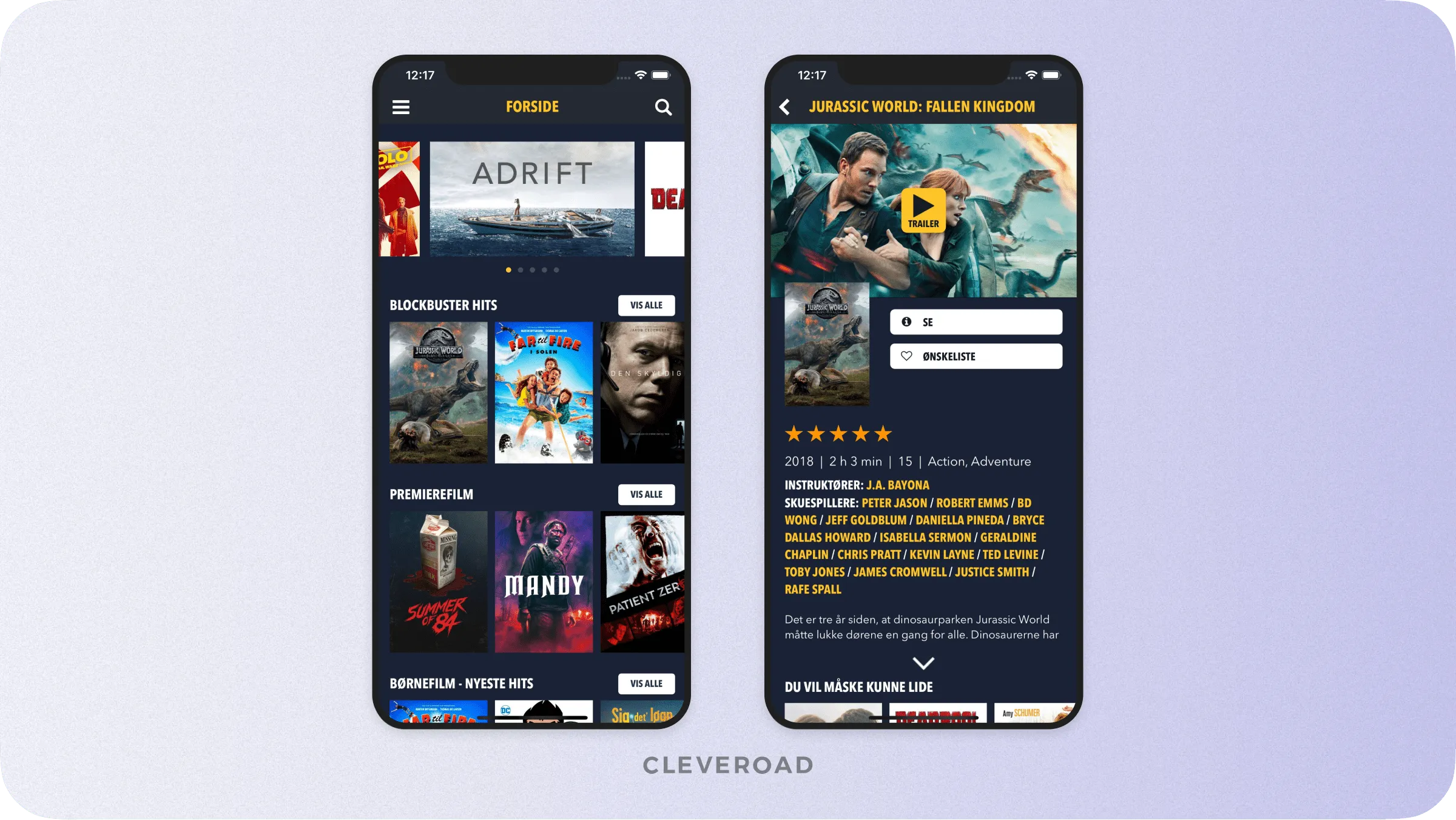
Cleveroad expertise: Blockbuster
One more great business software case from Cleveroad is Crossfader. Our customer from the UK is a company in the educational sector ensuring DJ training. Within the scaling process, it has become essential to upgrade the functionality of Crossfader, refine the client experience, and attract a broader audience. DJ Hub implementation, updated Admin panel, and transmission to iOS provided by Cleveroad have helped to obtain the set goals successfully.
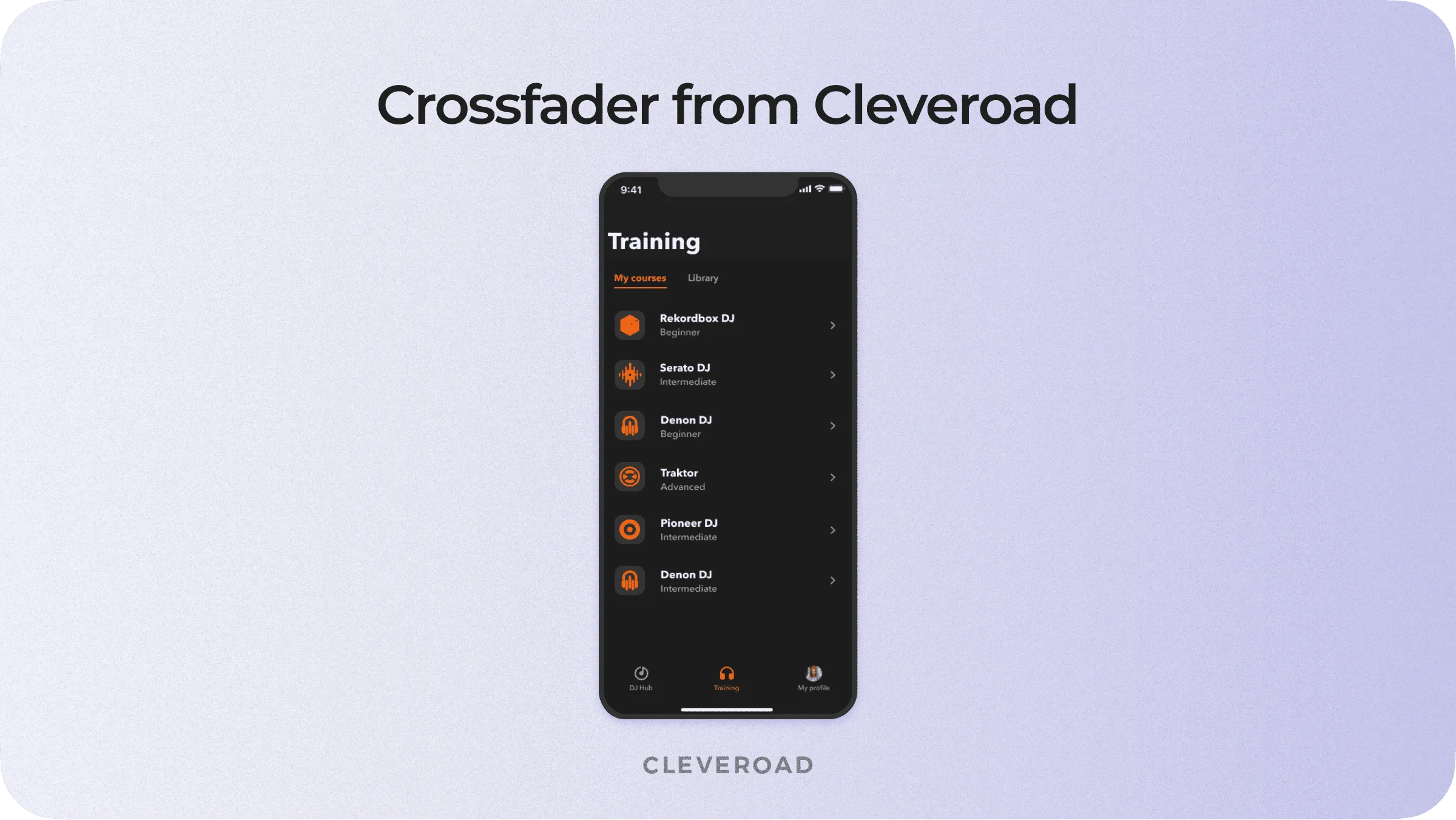
Crossfader project case from Cleveroad
The aforementioned and our other products significantly improve the bottom line for the business since they generate a new value stream for the customer. Efficient audience engagement and retainment are critical points to business prosperity.
Boost your business with solid app
Get consulted on the tech stack by Cleveroad tech experts and order top-class software
To create an app for your business you have to come up with clear requirements. Conduct user research to understand what platforms are relevant for your audience. Then, create a detailed feature list for your app. Don't over complicate your app with features that may appear useless for users. Finally, find a that will build a quality product for you.
While searching for programmers, you have three main options:
- Outsourcing software development company
- In-house team of developers
- Freelance developers
Each of them has its pros and cons. For example, in-house teams grant you complete control over the development process, but a full team may cost you a fortune. On the other hand, outsourcing companies are more cost-efficient, but you may experience some communication issues. Here's our detailed guide on how to find programmers for your project.
Native development means that engineers build the same app independently for different platforms. This approach provides superb performance and an attractive design. However, in exchange, it doubles the development time compared to hybrid app development.
Hybrid apps display the app's content in a web-view. This results in poor design and a lack of custom features. Nevertheless, hybrid apps are developed for both platforms simultaneously. So, the development time for iOS and Android with the hybrid approach is the same as the time to develop an iOS app with a native approach. More about the differences between native and hybrid apps in our guide.
Software development companies follow these algorithm to create mobile apps:
- Planning phase
- Market research
- Creating UI/UX design
- Software development
- Quality assurance
- Maintenance and support
Here are the most trendy niches for business app development:
- Food delivery
- E-commerce
- Streaming
- Telehealth
- E-learning
Flutter is the most promising cross-platform framework for business app development. It offers uncompromising performance compared to other frameworks. Besides, Flutter doesn’t have issues with the design. Its main concept is “everything is a widget”. In simple words, developers can customize each element on the layout per requirements.
An effective way to conduct the market research is the SWOT analysis, which refers to the method of planning and a tool for evaluating external and internal factors which affect the way a company or a specific application develops on the market. This acronym includes the following items:
- S (Strengths) - potent and solid aspects, characteristics of the business that distinguish it from its competitors
- W (Weaknesses) - infirm sides, which make the company vulnerable, reduce its competitiveness in comparison with other players in the sector
- O (Opportunities) - possibilities, elements of the environment that the company can use for development;
- T (Threats) - dangers, elements of the environment that can cause damage to the business
These components are divided into factors of the external and internal environment. In the first case, it is usually about the characteristics of the business, which it can deal with or impact. In the second case - the factors can only be beaten or at least neutralized.

Evgeniy Altynpara is a CTO and member of the Forbes Councils’ community of tech professionals. He is an expert in software development and technological entrepreneurship and has 10+years of experience in digital transformation consulting in Healthcare, FinTech, Supply Chain and Logistics
Give us your impressions about this article
Give us your impressions about this article
Comments
1 commentsI just want to thank you for posting this content I really find it useful. Please keep me posted for more updates.

Thanks! It's a pleasure for us to share our expertise with you